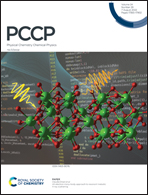Design and synthesis of piezochromic materials exploring intermolecular charge transfer: chalconoids bound to the p-sulfonatocalix[6]arene macrocycle†
Abstract
Solid-state systems composed of chalconoid encapsulated within p-sulfonatocalix[6]arene (SCX6) scaffolds that exhibit mechanochromism and thermochromism have been developed. An introduction of a supramolecular host promises a variety of applications in diverse areas, which makes them fascinating. Largely hydrogen bonding as well as π···π interactions are responsible for the host–guest complexation. The complex shows partial encapsulation of the guest with one of the phenyl rings of chalcone (guest) is held inside the SCX6 cavity, whilst other phenyl rings that exclude the cavity are hydrogen-bonded to sulfonate portals of the host. The hydrogen bonding conducing such complexation triggers proton transfer engendering a mechanochromic switch. The complexes are further characterized by a variety of experiments such as cyclic voltammetry (CV), steady-state fluorescence, vibrational spectroscopy, and 1H or 2D NMR (NOESY) spectroscopy experiments. Detailed structure furnished through the NMR shows deshielding of the Ha-e (guest) protons whereas, the hydroxyl protons from the host experience shielding as evidenced from the 1H NMR spectra. These inferences have further been corroborated through the density functional theory. Electrochemical investigations suggested an irreversible one-electron transfer in the host–guest binding. The characteristic ‘frequency shift’ for the intense carbonyl vibration in the infrared spectra, which can be correlated to the kinetic energy density parameter, G(r), in the quantum theory of atoms in molecules (QTAIM).
![Graphical abstract: Design and synthesis of piezochromic materials exploring intermolecular charge transfer: chalconoids bound to the p-sulfonatocalix[6]arene macrocycle](/en/Image/Get?imageInfo.ImageType=GA&imageInfo.ImageIdentifier.ManuscriptID=D2CP01483A&imageInfo.ImageIdentifier.Year=2022)


 Please wait while we load your content...
Please wait while we load your content...